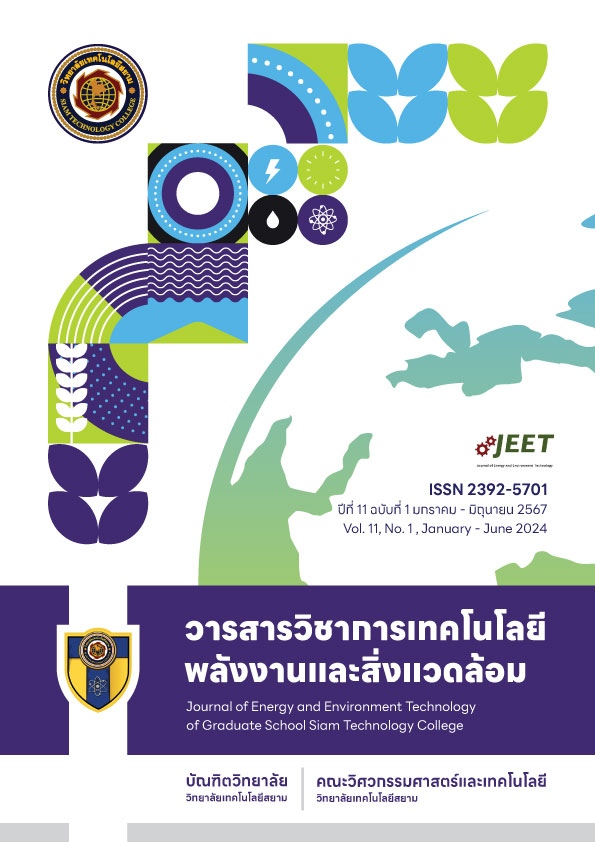ANALYTICAL STUDY FOR REDUCE ENERGY LOSS IN COMPRESSED AIR SYSTEMS
Main Article Content
Abstract
This research is to improve the efficiency of the air system and the loss of air pressure in the distribution system because the compressed air system is the tool and source in the air pressure production process. To pass on to other power-saving machinery and equipment in the pneumatic system and measuring instrument control system. Pneumatic conveyor systems are used to reduce human effort in many production processes. Compressed air is required for various pneumatic equipment such as air cylinders, air guns, polishing machines, drilling machines, spraying machines and conveying machines, as well as being a component in the use of various automatic machines. Reciprocating air compressors have sizes ranging from ¼ horsepower and up, but those commonly used in industrial plants have sizes ranging from 5–15 horsepower (3.7–11.0 kW). This research was conducted specifically. Piston air compressor that has been used for 9 years. Belt-type air pump, PP310A 10HP 3 cylinders 260 liters, 380V. The research results found that electrical energy used before the renovation was 21,060 kWh/year, and electrical energy used after the renovation was 19,699 kWh/year. Electrical energy can be reduced to 1,361 kWh/year, accounting for 6.46%.
Article Details

This work is licensed under a Creative Commons Attribution-NonCommercial-NoDerivatives 4.0 International License.
เนื้อหาและข่อมูลในบทความที่ลงตีพิมพ์ในวารสารวิชาการ เทคโนโลยี พลังงาน และสิ่งแวดล้อม บัณฑิตวิทยาลัย วิทยาลัยเทคโนโลยีสยาม ถือเป็นข้อคิดเห็นและความรับผิดชอบของผู้เขียนบทความโดยตรง ซึ่งกองบรรณาธิการวารสารไม่จำเป็นต้องเห็นด้วย หรือว่าร่วมรับผิดชอบใด ๆ
บทความ ข้อมูล เนื้อหา รูปภาพ ฯลฯ ที่ได้รับการตีพิมพ์ในวารสารวิชาการ เทคโนโลยี พลังงาน และสิ่งแวดล้อม บัณฑิตวิทยาลัย วิทยาลัยเทคโนโลยีสยาม ถือเป็นลิขสิทธิ์ของวารสารวิชาการ เทคโนโลยี พลังงาน และสิ่งแวดล้อม บัณฑิตวิทยาลัย วิทยาลัยเทคโนโลยีสยาม หากบุคคล หรือหน่วยงานใดต้องการนำทั้งหมด หรือส่วนหนึ่งส่วนใดไปเผยแพร่ต่อ หรือเพื่อกระทำการใด ๆ จะต้องได้รับอนุญาต เป็นลายลักษณ์อักษรจากวารสารวิชาการ เทคโนโลยี พลังงาน และสิ่งแวดล้อม บัณฑิตวิทยาลัย วิทยาลัยเทคโนโลยีสยาม เท่านั้น
References
กรมพัฒนาพลังงานทดแทนและอนุรักษ์พลังงาน. (2547). ตำราฝึกอบรมหลักสูตรผู้รับผิดชอบด้านพลังงาน (ผชพ.) สามัญ.
กรมพัฒนาพลังงานทดแทนและอนุรักษ์พลังงาน. (2550). คู่มือมาตรฐานการอนุรักษ์พลังงานในอาคาร.
กรมพัฒนาพลังงานทดแทนและอนุรักษ์พลังงาน กระทรวงพลังงาน. (2004). ตำราฝึกอบรมผู้รับผิดชอบด้านพลังงานอาวุโส (ผอส.) ด้านความร้อน ตอนที่ 4 บทที่ 1 ระบบอัดอากาศ ปั๊มน้ำและพัดลม หน้า 1-1 – 1-72.
กรมพัฒนาพลังงานทดแทนและอนุรักษ์พลังงาน. กระทรวงพลังงาน. (2560). คู่มือผู้รับผิดชอบพลังงาน ตอนที่ 2 บทที่ 5 การอนุรักษ์พลังงานสำหรับระบบอากาศอัด หน้า 4–65.
กรมพัฒนาพลังงานทดแทนและอนุรักษ์พลังงาน. (2555). การตรวจวิเคราะห์การอนุรักษ์พลังงานระบบอากาศอัด. กระทรวงพลังงาน, คู่มือการตรวจวิเคราะห์การอนุรักษ์พลังงาน สำหรับวิสาหกิจขนาดกลางและขนาดย่อม หน้า 6-1 – 6-6 .
ประกอบ เอี่ยมสอาด. (2549). การบริหารจัดการพลังงาน ในระบบอากาศอัด ของโรงงานอุตสาหกรรม. วิทยานิพนธ์วิศวกรรมศาสตร์ มหาบัณฑิต มหาวิทยาลัยเทคโนโลยี พระจอมเกล้าธนบุรี.


